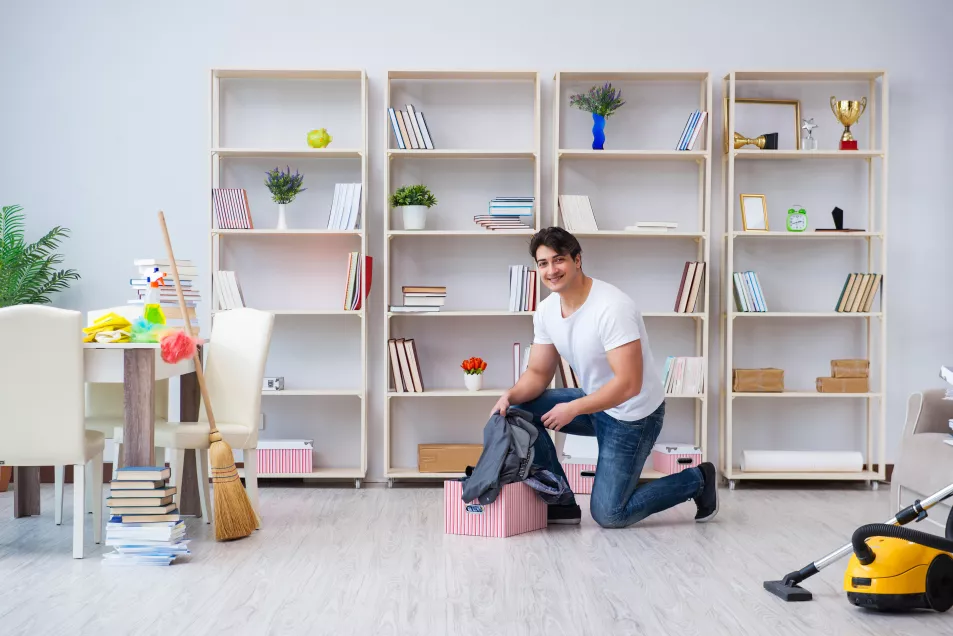Is your home full of stuff you might not need, but you haven’t got round to clearing out?
Possibly it’s because it brings back memories, or you can’t decide what to do with it – so you’ve ended up with a house full of clutter.
“Ultimately, clutter is decisions that haven’t been made,” says psychotherapist and interior designer Helen Sanderson (helensanderson.com), author of The Secret Life Of Clutter. “Things end up in a pile, container or drawer because that seems easier than deciding where to put them or what to do with them.
“You say, ‘I’ll deal with that later’, and probably mean it. But weeks, months or even years later, it’s still there, buried beneath countless subsequent things you’ve not processed.”
Sanderson says there are many reasons people avoid decisions in this way. “It’s often because of the meaning and emotions we attach to our possessions,” she says. “Memories of a trauma, or an unrealised creative project get stirred when we open those drawers. Sometimes it’s simply a busy life, or never having learned how to create order in the home. Usually, it’s some combination of these.”
So, while on the surface, clutter is about how we deal with physical stuff, it’s often rooted in something deeply psychological, explains Sanderson, who says although we often want to create beautiful, clutter-free homes, something in our psychology sabotages that.
“Regardless of how much decluttering you do, if you don’t identify and address those underlying issues, the clutter will inevitably come back,” she says. “Once you truly understand what’s underneath your clutter, and listen to the story it has to tell, it empowers you to make a deeper shift and make room for your clutter-free home.
However, she’s not suggesting people clear everything out. “I certainly don’t encourage the people I work with to live in pristine, ascetic white spaces,” says Sanderson. “I believe there’s a balance to be struck in our homes between chaos and order, allowing us clear, harmonious spaces that give us room to think while still having a healthy amount of stuff that we love, find useful, or simply don’t want to lose.”
Sanderson’s 10 steps to decluttering your home
1. A cluttered home is like an overgrown garden
Sanderson says it can be useful to think of cluttered homes as overgrown gardens that need weeding, planting and maintaining. “The weeding process is about making all those unmade decisions, such as keep, let go, or action. Planting means creating a plan, placing things in a beautiful, harmonious way and optimally organising what you choose to keep: a place for everything and everything in its place. And maintaining is about building new habits with compassionate self-discipline, so your home supports you to live with greater ease.“
It’s crucial to declutter in this order, she says. “Forming habits in cluttered chaos sets the bar too high. Start with letting go and once you’re clear, maintain.”
2. Create a clear vision

Imagine exactly how you’d like your home to be. Write it down or create a vision board of inspiring images from magazines or Pinterest. Then write down why you want to create space and order – is it for a creative project? Do you want to feel more comfortable inviting people round?
3. Understand the reality
Look inside all the cupboards, drawers and boxes and establish a clear picture of exactly what you’re dealing with. “This isn’t to discourage you, but so you can effectively plan your declutter project. It will also help motivate you by creating a tension between where you are now and your vision of where you want to be.”
4. Break decluttering into manageable stages
This can be room by room, cupboard by cupboard, or drawer by drawer, says Sanderson. “I recommend you master one room, then move to another. It’s important to experience successes, even small ones.”
5. Identify obstacles and how to overcome them
Are you a big procrastinator, easily distracted or likely to get very emotional? Are you going to find it hard to make time to do the work? Do you get brain-freeze when you see the chaos and then struggle to make decisions?
“Once you’ve understood the barriers you might face, put some clear strategies in place to help you overcome them,” advises Sanderson, who suggests you might get a friend to help, or even consider employing a professional organiser or coach.
6. Set aside time and remove distractions
Sanderson points out that if someone really loved decluttering, they’d have done it long ago. “Accept that once you start, other things are likely to be much more appealing than sorting out those piles of stuff,” she suggests. “So turn off your phone, cancel other plans and send the family and even the pets out – unless they’re helping.” She even recommends taking time off work to fully focus on the project
7. Put some clutter in front of you
Start a timer, collect your stuff and stack it in front of you – so take out a stack of books, paperwork or empty a drawer into a box. “What works best is if you can have someone to help,” says Sanderson. “Their job is simply to bring things to you, and your job is simply to make decisions. No putting things away, just ask: Is this staying or going?”
8. Keep, Recycle, Bin, Donate, Action

One by one, decide are you going to recycle, sell, keep, bin, action, or donate each item – these are the core decisions that have to be made, says Sanderson, who advises people to work quickly, trust their intuition and keep going.
She also suggests creating a ‘Don’t Know’ pile to help maintain momentum. “That way, if you aren’t sure, you can put the item there and come back to it later, instead of breaking your flow of decisions.” However, if the ‘Don’t know’ pile gets too big, it’s important to check in with your goals and vision to refocus.
9. Complete it
Make sure you allocate time at the end of the session to complete the job properly – this means immediately taking out the recycling and rubbish, and putting all donations in the car, so you’re not tempted to review your decisions and undermine your hard work. “Completion here is key,” stresses Sanderson.
10. Plant and maintain
The next stage is the planting stage, when you efficiently categorise and put everything away, followed by maintaining what you’ve achieved. “Accumulated clutter can represent a life lived in the past,” says Sanderson. “By creating space in your home, you’re making room for new experiences and opportunities.”

The Secret Life Of Clutter: Getting Clear, Letting Go And Moving On by Helen Sanderson is published by Piatkus. Available now.







